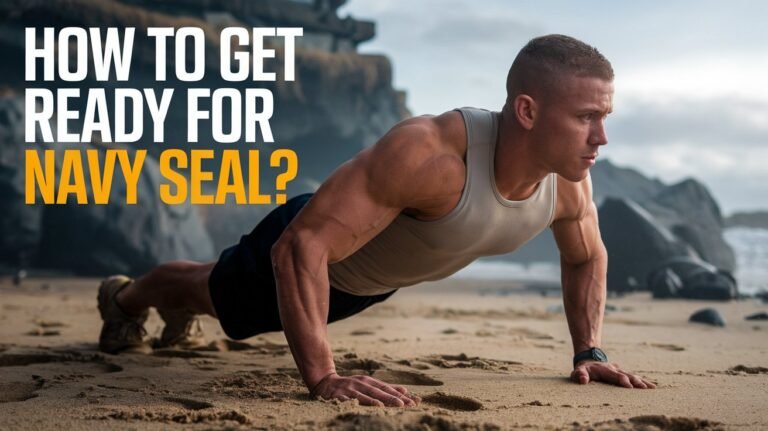How To Become A Navy Seal? Training & Requirements

Becoming a Navy SEAL is tough. It needs top physical shape and strong mental toughness. To start, you must meet certain navy seal requirements. This includes being the right age, a U.S. citizen, and having the right education.
The journey includes passing a Physical Screening Test. Then, you must finish the Basic Underwater Demolition/SEAL training. This is a big part of navy seal training.
Those dreaming of becoming a Navy SEAL should know the dropout rate is high. This shows how tough the selection is. But, with the right attitude and prep, you can beat the challenges. You can become part of this elite group by meeting the navy seal requirements and finishing the tough training.
Navy SEAL Basic Requirements and Standards
To become a Navy SEAL, you need to meet certain requirements. These include age, citizenship, and physical fitness standards. You must be between 17 and 28 years old, but waivers can extend this to 30.
You also need to be a U.S. citizen and have a high school diploma or its equivalent. Physical fitness is key, with tests like the Physical Screening Test (PST).
The PST checks your swimming, push-ups, sit-ups, and running skills. You must swim 500 yards in 12 minutes, do 42 push-ups in two minutes, and 50 sit-ups in the same time. You also need to run 1.5 miles in 11 minutes.
Age and Citizenship Criteria
Candidates must meet age and citizenship requirements to join Navy SEAL training. They should be between 17 and 28 years old and be a U.S. citizen.
Physical Fitness Benchmarks
The navy seal physical fitness requirements are strict. You must pass the PST and meet swimming, push-up, sit-up, and running standards. The PST competitive standards are even higher.
For the PST, you need to swim 500 yards in 9 minutes, do 100 push-ups in two minutes, and 100 sit-ups in the same time. You also have to run 1.5 miles in 9 minutes.
Education Prerequisites
Candidates must have a high school diploma or equivalent to join Navy SEAL training. They also need to meet ASVAB score requirements. This includes a minimum AFQT score of 35 and a minimum line score combination of GS + MC + EI = 170 or VE + MK + MC + CS = 220.
Physical Conditioning Demands
To become a Navy SEAL, you must pass tough physical tests. The navy seal physical conditioning is very challenging. It includes swimming, running, and strength training.
A typical navy seal workout is a 500-yard swim in 12:30 minutes or less. You also need to do 42 push-ups in 2 minutes, 50 sit-ups in 2 minutes, and 6 pull-ups in 2 minutes. Plus, a 1.5-mile run in 10:30 minutes or less. These tests show if you’re fit enough to be a Navy SEAL.
The following table outlines the minimum and competitive standards for the Navy SEAL Physical Screening Test (PST):
| Event | Minimum Standard | Competitive Standard |
|---|---|---|
| 500-yard swim | 12:30 | 10:30 |
| Push-ups | 42 | 79 |
| Sit-ups | 50 | 79 |
| Pull-ups | 6 | 11 |
| 1.5-mile run | 11:00 | 10:20 |
Meeting the competitive standards can help you get into the Navy SEAL program. Remember, these standards can change. Always try to do better than the minimum to stay competitive.
Basic Underwater Demolition/SEAL Training Phases
The navy seal bud/s training lasts 24 weeks and is split into three phases. Each phase has its own set of challenges and requirements. The first phase, or “conditioning phase,” prepares candidates for the physical demands of the training.
The navy seal training phases test candidates’ physical and mental limits. The second phase, or “dive phase,” focuses on underwater skills like scuba diving and navigation. The third phase, or “land warfare phase,” teaches combat skills, including marksmanship, first aid, and tactics.
Some key skills learned during the navy seal bud/s training include:
- Underwater navigation and scuba diving
- Marksmanship and combat skills
- First aid and medical skills
- Land navigation and tactics
Navy seal training phases are tough, both physically and mentally. The training is intense but rewarding for those who finish it. Those who complete the navy seal bud/s training are ready for the challenges of being a navy seal. They have the skills and knowledge needed to succeed in their careers.
Mental Fortitude and Psychological Screening
Navy SEAL training is tough, but it’s not just about physical strength. Mental toughness and psychological screening are just as important. About 70% of people drop out during SEAL selection, showing how crucial navy seal mental toughness is. To get ready, candidates practice meditation, visualization, and positive self-talk.
Navy seal psychological screening focuses on staying calm under extreme stress. They learn techniques like the 4×4 breathing method. This involves breathing in for 4 seconds and out for 4 seconds for at least 1 minute. Key parts of mental toughness training include:
- Goal setting: breaking down goals into small steps
- Visualization: imagining scenarios to prepare for stress
- Positive self-talk: reminding oneself of the ability to finish
- Stress management: learning to react quickly
Using these methods, Navy SEALs prepare for high-pressure situations. Mental toughness training combines physical and mental strength. It reflects the Navy SEAL Ethos, which values selflessness and teamwork.
How to Become a Navy SEAL: The Complete Process
To become a Navy SEAL, you must go through a tough process. It starts with meeting basic requirements like age and education. Then, you pass the Physical Screening Test (PST) and complete Basic Underwater Demolition/SEAL (BUD/S) training.
Journey includes five phases in the navy seal training pipeline. Each phase lasts about 4 weeks, adding up to 24 weeks of training. It’s important to know that about 70-80% of trainees drop out. So, being well-prepared and dedicated is key.
Enlistment Procedures
Before starting the training, candidates must enlist. This involves passing tests like the SEAL Physical Screening Test (PST) and the Armed Services Vocational Aptitude Battery (ASVAB). Higher scores on these tests mean a better chance of success in SEAL training.
Training Pipeline Structure
The training pipeline is tough, testing candidates’ physical and mental limits. It includes swimming, running, and other challenging activities. Candidates also get advanced training in skills like parachuting and sniper training.
| Phase | Duration | Description |
|---|---|---|
| Physical Conditioning | 4 weeks | Physical training to prepare candidates for the challenges of BUD/S |
| Dive Phase | 4 weeks | Training in diving and underwater operations |
| Land Warfare Phase | 4 weeks | Training in land warfare tactics and techniques |
| Survival, Evasion, Resistance, and Escape (SERE) Training | 4 weeks | Training in survival, evasion, resistance, and escape techniques |
| Final Training Phase | 4 weeks | Final training and preparation for graduation |
Understanding the navy seal training pipeline and enlistment process helps candidates prepare. With hard work and dedication, it’s possible to succeed and join the Navy’s special operations forces.
Medical Clearance Requirements
To become a Navy SEAL, you must pass a physical exam and meet health standards. These include vision, hearing, and other health factors. The requirements are strict to ensure candidates can handle the training’s demands.
The Physical Screening Test (PST) is key in the selection process. Candidates must meet certain standards. These include swimming 500 yards in 12:30 minutes, doing 42 push-ups in 2 minutes, and more.
- 500-yard swim in 12:30 minutes or less
- 42 push-ups in 2 minutes or less
- 50 sit-ups in 2 minutes or less
- 1.5-mile run in 10:30 minutes or less
- 6 pull-ups with no time limit
Candidates also need to pass a physical exam and meet health standards. The medical clearance process is thorough. It ensures candidates are healthy enough for the training.
Meeting these medical and physical standards, candidates can qualify for Navy SEAL training. This sets them up for success in this challenging and rewarding career.
SEAL Team Assignment Protocol
After finishing BUD/S training, candidates join a SEAL team. They get specialized training and work with other SEALs on missions. The team assignment is based on skills, experience, and BUD/S performance.
Candidates might become snipers, medics, or communications specialists. The team integration process helps SEALs work together well. This is key for the team’s success and safety.
Specialized Roles
Some roles include:
- Sniper: provides precise fire support
- Medic: offers medical help
- Communications specialist: keeps the team connected
Team Integration Process
The integration process includes training and simulations. It tests the team’s ability to work together. This is vital for seamless teamwork and mission success.
Process builds teamwork, communication, and respect. It prepares candidates for SEAL team challenges. The team assignment and integration are essential parts of SEAL training.
| SEAL Team | Location | Specialized Roles |
|---|---|---|
| SEAL Team 1 | Naval Amphibious Base Coronado, California | Sniper, medic, communications specialist |
| SEAL Team 2 | Naval Amphibious Base Little Creek, Virginia | Sniper, medic, communications specialist |
Post-Qualification Career Paths
After finishing Basic Underwater Demolition/SEAL (BUD/S) training, candidates join a SEAL team. They can then take advanced training in areas like parachuting, sniper training, and language skills. This is part of the navy seal advanced training program.
There are many navy seal career paths for qualified SEALs. These include:
- Specialized roles, such as sniper or parachuting specialist
- Leadership positions, such as platoon commander or team leader
- Advanced education, such as a bachelor’s or master’s degree
- Careers in law enforcement, private security, or consulting
These navy seal post-qualification career paths offer many opportunities. SEALs can use their skills in different fields. With the right training and experience, they can find careers in and out of the military.
Military Service Impact on Political Careers
Military service, like being a Navy SEAL, greatly affects political careers. It shows leadership, discipline, and a dedication to public service. Many politicians, including presidents and Congress members, have been in the military, some as Navy SEALs. The mix of navy seal military service and political involvement is growing in the U.S.
Pete Buttigieg is a great example. He was in the military from 2009 to 2017. His time as a Navy SEAL likely shaped his political career. His navy seal background has been a key part of his political journey, showing how military service prepares people for leadership.
Service Record Verification
Checking a candidate’s military service is crucial in politics. It confirms their service and checks if they’re eligible for office. For those with a navy seal background, this is even more important. It proves their credibility and readiness for public office.
Public Service Transitions
Going from military to politics is common for many. The skills from navy seal service, like leadership and strategy, are valuable in public roles. With 96 veterans in Congress in 2021, the navy seal impact on politics is clear and lasting.
Common Misconceptions About SEAL Service
Many people think SEAL training is easy or that SEALs only fight. But, the truth is, training is tough, both in body and mind. SEALs do more than just fight; they also do counterterrorism, direct action, and special reconnaissance.
One big myth is that SEAL training is a breeze. But, only a few make it through BUD/S training. On average, a Navy SEAL serves for 10-15 years.
Training Success Rates
Only a small number of people finish Navy SEAL training. This is because the training is incredibly hard. It tests candidates to their limits.
Service Duration Facts
Navy SEALs usually serve for 10-15 years. This is a big commitment. They do many jobs, like counterterrorism and special reconnaissance. They must be ready to serve for a long time.
| Category | Description |
|---|---|
| Navy SEAL Training | Extremely challenging, both physically and mentally |
| Navy SEAL Operations | Counterterrorism, direct action, and special reconnaissance |
| Navy SEAL Service Duration | Typically around 10-15 years |
It’s important to know the truth about Navy SEALs. Misconceptions can be harmful. They can make people think SEALs’ work is easier than it is. By understanding the real deal, we can respect their sacrifices more.
Wrap-Up Thoughts
Becoming a Navy SEAL is a tough and changing journey. It needs total dedication, top physical shape, and a strong will. The path is filled with challenges that only the most determined can face.
But for those who make it, the rewards are huge. Navy SEALs are known for their bravery, skill, and deep commitment. They are symbols of American military strength, making a big impact worldwide. They do everything from combat to helping others, showing the best of the US Armed Forces.
If you’re thinking about this journey, remember it’s about growing, being strong, and always striving to be the best. With the right attitude, training, and drive, you can become part of this elite group. You’ll leave a lasting mark of service and bravery.
Answered Queries
What are the basic requirements to become a Navy SEAL?
To join the Navy SEALs, you need to be between 17 and 28 years old. You must also be a U.S. citizen and have a high school diploma or equivalent. You’ll have to pass the Physical Screening Test (PST) and finish the Basic Underwater Demolition/SEAL (BUD/S) training.
What is the physical conditioning required for Navy SEAL training?
Navy SEAL training is tough. It tests your swimming, running, and strength skills. You’ll face obstacle courses and underwater tasks that push you to your limits.
What are the different phases of the Basic Underwater Demolition/SEAL (BUD/S) training?
BUD/S training has three phases. The first is the “conditioning phase” to get ready for the physical challenges. The second is the “dive phase” for underwater skills. The third is the “land warfare phase” for combat training.
How important is mental fortitude and psychological screening for Navy SEAL training?
Mental strength is key in Navy SEAL training. You need to handle the physical and mental challenges. The training aims to test your limits in both areas.
What is the process of becoming a Navy SEAL?
Becoming a Navy SEAL starts with meeting the basic requirements. Then, you pass the Physical Screening Test (PST). After that, you complete the BUD/S training and advanced training in specialized areas.
What are the medical clearance requirements for Navy SEAL training?
Medical checks are crucial for Navy SEAL training. You must be in good health to handle the training. This includes passing a physical exam and meeting vision, hearing, and health standards.
How are Navy SEALs assigned to their teams?
After BUD/S, you’re assigned to a SEAL team based on your skills and performance. The team integration process helps you work well with others to complete missions.
What are the career paths available for Navy SEALs after completing their training?
Navy SEALs can get advanced training in areas like parachuting and sniper training. They can also get degrees and work in fields like law enforcement and private security.
How does military service, including as a Navy SEAL, impact political careers?
Military service, like being a Navy SEAL, can boost a political career. It shows leadership, discipline, and a commitment to public service. The service record and public service transitions are key for politicians with military backgrounds.
What are some common misconceptions about Navy SEAL service?
Many people think SEAL training is easy or that SEALs only do combat. But, the training is very challenging, and SEALs do many different operations.






